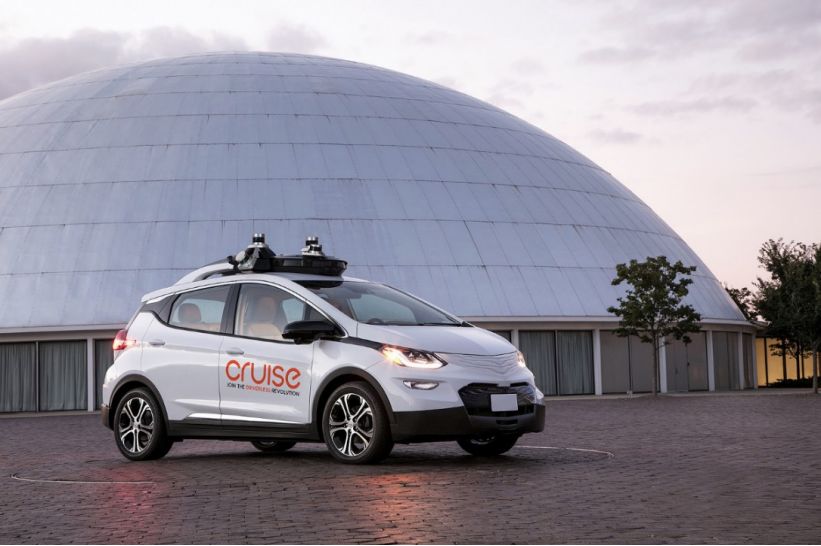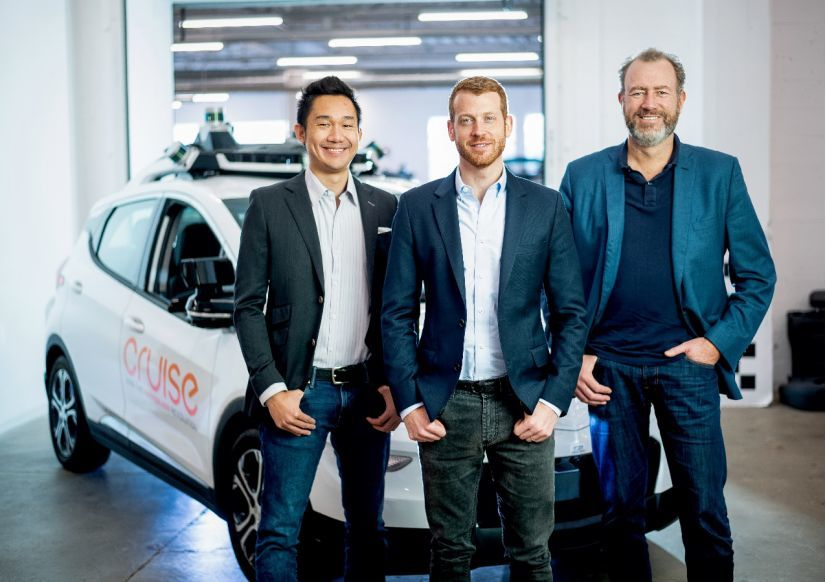On November 30th, 2018, General Motors announced the appointment of Dan Ammann as CEO of Cruise, its autonomous driving technology subsidiary. This marks the beginning of General Motors’ redemption after its previous announcement of laying off 14,700 employees and implementing a cost-cutting plan of $6 billion.
Dark Horse, Cruise
If in late 2016, many traditional OEMs were skeptical about autonomous driving and chose to stand by the sideline, at the end of 2018, there is no car company that would deny that autonomous driving will profoundly reshape the existing business models of the automotive industry. Whoever can master autonomous driving technology will obtain the key ticket to the future.
Over the past two years, many combinations of traditional OEMs and emerging autonomous driving startups have emerged, such as GM + Cruise, Ford + Argo.ai, Volkswagen/Hyundai + Aurora… However, only one combination has truly emerged: GM + Cruise.
Why is it said that only Cruise has succeeded? There are several clear data points to support this.
Almost all companies that conduct autonomous driving road tests in Silicon Valley have applied for an autonomous driving license from the California Department of Motor Vehicles (DMV). At the beginning of each year, the DMV discloses the autonomous driving road test data and relevant technology progress of car companies, which is the big picture.
In 2016 and 2017, Cruise ranked second among the 60 autonomous driving research and development companies holding autonomous driving test licenses in California, with the first being the industry leader Waymo, which has been developing autonomous driving since 2009. Therefore, the conclusion is that Cruise started from a high point, but did not surpass Waymo, so there was not much technological progress?
The comparison between the road test data of Waymo and Cruise over the past two years is shown below.

It can be seen that Cruise has increased from less than 10,000 miles in 2016 to 125,000 miles in 2017, while Waymo has decreased from 636,000 miles in 2016 to 35,300 miles. However, it is not a big problem as Waymo’s figures are still higher than those of Cruise.
The next indicator is the frequency of human intervention required per thousand miles of autonomous driving.
From 2016 to 2017, Waymo’s frequency of human intervention decreased slightly from 0.2 interventions per thousand miles to 0.18 interventions per thousand miles, whileCruise achieved a breakthrough from 18.5 interventions per thousand miles to 0.84 interventions per thousand miles, crossing another order of magnitude.Do you understand? Regardless of road test data or frequency of manual intervention, Cruise lags behind Waymo, but Cruise’s efficiency in technology improvement is far higher than Waymo’s, why?

In the report submitted to the California DMV, Cruise mentioned its unique road test approach: taking on the toughest challenges. Cruise conducts tests directly in the most complex road conditions, which means that the system will encounter extreme conditions more frequently and the speed of technological improvement will be faster.
This strategy is very different from the mainstream autopilot testing strategy. A number of car companies, including Waymo, usually start with simple suburban road conditions and challenge increasingly complex traffic environments.
Cruise CEO Kyle Vogt once introduced in a blog that compared to other regions, the probability of Cruise’s test vehicle team encountering extreme road conditions in San Francisco has increased by 46 times. This means that even though Cruise’s fleet size is smaller than Waymo’s, single vehicle efficiency and test quality will be more efficient.
Vogt said that most companies underestimated the difference in road conditions between urban and suburban areas. In some cases, the challenge of urban road conditions even reached 4658% of that of suburban road conditions. As the number of objects that need to be dealt with on the road increases, the interaction of autonomous vehicles will actually increase exponentially rather than linearly.
In addition, Cruise’s team has grown from more than 40 people since its acquisition in 2016 to more than 1000 people at present. The rise in team size and technical capabilities has given Cruise very good market returns. After receiving Softbank’s investment of $2.25 billion and Honda’s investment of $2.75 billion, Cruise’s valuation has risen to $14.6 billion.
From any dimension, Cruise has been a dark horse in the field of autonomous driving in the past three years.
Commercialization Leader Dan Ammann
Cruise’s official website has been updated, and General Motors President Dan Ammann will become Cruise’s CEO on January 1, 2019. Cruise Founder and CEO Kyle Vogt will become Cruise President and CTO.
 Here are some interesting developments worth pondering. First, in the official announcement, Dan stated that he is “glad to be able to devote 100% of his time and energy to supporting Kyle and the whole team” and that his responsibilities for General Motors’ global regional markets and General Motors financial business will now report directly to General Motors CEO Mary Barra.
Here are some interesting developments worth pondering. First, in the official announcement, Dan stated that he is “glad to be able to devote 100% of his time and energy to supporting Kyle and the whole team” and that his responsibilities for General Motors’ global regional markets and General Motors financial business will now report directly to General Motors CEO Mary Barra.
In other words, unlike Volkswagen Group CEO Herbert Diess, who personally doubles as Chairman of the Board of Management for Volkswagen China due to his emphasis on the Chinese market, Dan has completely abandoned his supervisory responsibilities within General Motors and has instead turned his full attention to the small Cruise team.
As for Dan himself, his earliest connection with General Motors dates back to 2009, when he was still Managing Director and Head of Industrial Investment Banking at Morgan Stanley, and provided consulting assistance to General Motors during the financial crisis.
In April 2010, Dan officially joined General Motors as Chief Financial Officer, leading General Motors’ first IPO after the financial crisis, following the bankruptcy of General Motors’ financial crisis.
In January and March 2016, Dan led two landmark investments/acquisitions, investing $500 million to lead the travel service platform Lyft, and acquiring Cruise for $1 billion. It is unclear if Dan encountered any internal resistance when promoting these two projects, but General Motors was undoubtedly the most radical transformation among the world’s traditional OEM giants at that time, making huge investments and betting on the future.
So it is only logical that he is responsible for Cruise’s coordination with other car companies and travel platforms, and pushing for the commercialization of self-driving cars.
Speaking of Cruise, in response to the commercialization of self-driving cars, Kyle stated in 2017 that “our plan is much faster than most people in the industry imagine, and 2018 (commercialization) is not surprising.” However, according to previous reports from Reuters, there are still some technical challenges for Cruise’s commercialization.

It should be pointed out that from the beginning of Cruise’s establishment, Kyle’s title was CEO and CTO, and he is a founder with a technical background. It wasn’t until September of last year that Cruise hired Uber’s engineering chief, AG Gangadhar as CTO. Just one year later, Kyle returned to his post as CTO, enabling him to better focus his energy on solving the technical and engineering challenges of self-driving cars.# About CEO Mary Barra of General Motors
Finally, let’s talk about CEO Mary Barra behind the scenes. If Dan is responsible for spending money to buy the future, Mary’s role in General Motors is a “cost killer”.
As a veteran General Motors employee who started as an intern and has worked there for 36 years, Mary did not hesitate to shut down and transform backward businesses on the eve of industrial change. Key nodes include the cost-cutting plan in 2015 with a total of 6.5 billion US dollars, the bundling and disposal of Opel and GM Europe to the PSA Group in 2017, and today’s massive layoffs plan.
On November 26th, General Motors announced a heavyweight plan: to cut 14,700 jobs by the end of 2019, accounting for 15% of the total number of employees, including one-fourth of management. At the same time, 7 major production bases worldwide will be closed.
General Motors’ intention is quite clear: according to calculations, this layoff will reduce General Motors’ cost by 6 billion US dollars. Cutting management is “to simplify the company’s decision-making process”; controlling costs is “to redirect more investment to electric and self-driving cars”.
It seems that every ambitious reformist CEO has the title of “cost killer”, including Volkswagen Group CEO Herbert Diess, former Renault-Nissan-Mitsubishi Alliance CEO Carlos Ghosn, and General Motors CEO Mary Barra, who left with regret.
It takes a price to bid farewell to the old era, and a CEO without strong determination cannot lead a giant to transformation.
 Leaving aside the Bug-level existence of Tesla’s autonomous driving field, the focus of the fight between Waymo and GM + Cruise is the commercialization of autonomous driving transportation services, which involves three key factors: algorithm, hardware, and operation. Waymo’s algorithm is clearly leading while Cruise is striving to catch up; however, in terms of hardware and operation, Waymo does not manufacture cars while GM has rich manufacturing experience. Waymo built its platform from scratch while GM invested in Lyft, which cannot be underestimated.
Leaving aside the Bug-level existence of Tesla’s autonomous driving field, the focus of the fight between Waymo and GM + Cruise is the commercialization of autonomous driving transportation services, which involves three key factors: algorithm, hardware, and operation. Waymo’s algorithm is clearly leading while Cruise is striving to catch up; however, in terms of hardware and operation, Waymo does not manufacture cars while GM has rich manufacturing experience. Waymo built its platform from scratch while GM invested in Lyft, which cannot be underestimated.
The latest situation is that Cruise has been listed as the highest priority of GM’s business, providing money and resources. So, Waymo or Cruise?
How to look at the autonomous driving arms race triggered by Waymo in GM?
How does GM, who bets heavily on autonomous driving, lay out the electrification?
This article is a translation by ChatGPT of a Chinese report from 42HOW. If you have any questions about it, please email bd@42how.com.
